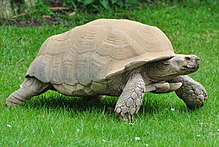
Geochelone sulcata

The African spurred tortoise (Centrochelys sulcata), also called the sulcata tortoise, is a species of tortoise, which inhabits the southern edge of the Sahara desert, in Africa. It is the third-largest species of tortoise in the world, the largest species of mainland tortoise, and the only extant species in the genus Centrochelys. Its specific name sulcata is from the Latin word sulcus meaning 'furrow' and refers to the furrows on the tortoise's scales. The African spurred tortoise is native to the Sahara Desert and the Sahel, a transitional ecoregion of semiarid grasslands, savannas, and thorn shrublands found in the countries of Burkina Faso, Chad, Eritrea, Ethiopia, Mali, Somalia, Mauritania, Nigeria, Senegal, and Sudan In these arid regions, the tortoise excavates burrows in the ground to get to areas with higher moisture levels, and spends the hottest part of the day in these burrows. This is known as aestivation. Burrows may average 30 inches in depth; some dig tunnel systems extending 10 feet or more underground. Plants such as grasses and succulents grow around their burrows if kept moist and in nature continue to grow for the tortoise to eat if the soil is replenished with its feces. There is a variant of this tortoise in Sudan, they differ by having a bigger overall body and shell. C. sulcata is the third-largest species of tortoise in the world after the Galapagos tortoise, and Aldabra giant tortoise, and the largest of the mainland tortoises. Adults can reach 83 cm (33 in) and can weigh 105 kg (231 lb). They grow from hatchling size (2–3 in) very quickly, reaching 6-10 in (15–25 cm) within the first few years of their lives. They can live more than 70 years. Sulcata tortoises are herbivores. Primarily, their diets consist of many types of grasses and plants, high in fiber and very low in protein. Flowers and other plants including cactus pads can be consumed.
